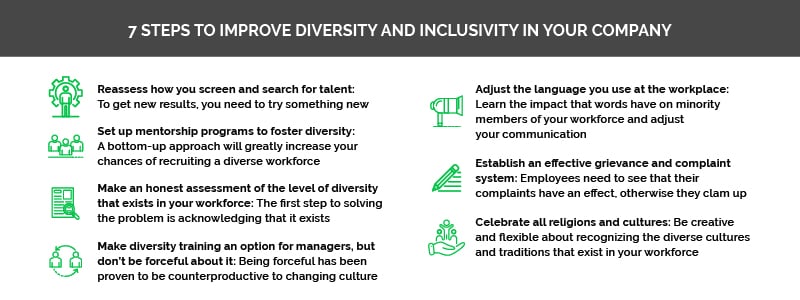7 Steps to Improve Diversity and Inclusivity In Your Company

A diverse, more inclusive workforce means better business, no matter the size of your company.

It’s hard to ignore the discrepancy that exists in the workplace concerning the employment of minority groups, just as it is hard to ignore how turning that trend around in your company will be good for business. Here are seven ways to foster diversity and inclusivity in your workforce:
1. Reassess how you screen and search for talent
Roughly 80% of job openings are never posted online or advertised. Instead, these positions are filled by referrals and internal hire systems, which gives your current workforce undue influence over who gets to join them. This is why many workforces that are overwhelmingly made up of one demographic continue to make more hires from that demographic.
Sticking with your current methods of recruiting — and their biases — will not help your business become more inclusive. So, make a commitment to change the way you screen and search for candidates to counteract those biases and follow through on it.
Practical strategies that help with this include using tools that hide names and photos from applications and social media, so demographics aren’t a consideration, and screening job descriptions before they are sent out.
2. Set up mentorship programs to foster diversity
Gather a diverse pool of talent for job openings by weaving inclusion into the recruitment process from the ground up. Only 15% of companies have college recruitment programs dedicated to women and minorities. Only 10% have dedicated mentorship programs in place. And for their effort, these companies enjoy a 9% to 24% improvement in minority representation in management.
This strategy has success engineered into it. According to Harvard Business Review, companies that started a college recruitment program dedicated to female employees saw the proportion of white and colored women (Black, Hispanic, and Asian-American) in its management rise by 10%. A similar thing happened when a minority recruitment program was instituted, where the proportion of Black male managers and Black female managers increased by 8% and 9% respectively.
3. Make an honest assessment of the level of diversity that exists in your workforce
The first step towards solving any kind of problem is acknowledging the problem exists and gauging its severity. In the case of improving the diversity and inclusivity in your workforce, not only does acknowledging the problem set you on the right path to a solution, but it also makes minority groups feel seen and respected.
This is important because when employees feel understood and respected, they are more likely to be engaged in their work.
4. Make diversity training an option for managers, but don’t force it on them
Diversity training reduces the biases that exist in management, which helps reduce the biases in the general workforce, so you want to make this available to anyone who wants it. The rub here is to make it available, rather mandatory, as that could prove counterproductive.
Research carried out by the University of Toronto involving white participants who read a brochure about prejudice towards Black people showed that, when the participants were pressured to agree with the content, their biases were strengthened. On the other hand, when given the freedom to choose whether or not to agree, their biases were reduced.
You also don’t want to make this training a one-off. Instead, institute a series of programs for continued learning in order to avoid regression to past behavior.
5. Adjust the language you use at work
Nothing raises people’s awareness of your willingness to walk the walk like when you talk the talk. Your employees, and potential candidates and customers, will only take your drive towards diversity and inclusivity seriously when your words are clearly consistent with your intentions. Communication channels like job descriptions, employee manuals, employment contracts, websites, and others need to bear clearly inclusive language.
This goes beyond strategically placing buzzwords like ‘equity”, “inclusion”, and “diversity” in your memos, and resists the temptation to redefine what diversity actually is. It means respecting proper usage and understanding of words and their impact in matters concerning race and ethnicity
6. Establish an effective grievance and complaint system
An effective grievance and complaint system is integral to any atmosphere that supports inclusivity. Nothing makes employees scoff at a grievance system more than when it doesn’t ward off or end bad behavior in the organization. People simply clam up when they feel their protests don’t bear fruit. In fact, data shows that while 76% of Black employees and 58% of Hispanic employees have suffered racial harassment at the office, only 1% of these instances have been formally reported.
7. Celebrate all religions and cultures
A strong sign that we need to take the inclusivity discussion more seriously is the fact that 66% of American workers have the day after thanksgiving off while only 39% of workers have the day off after Martin Luther King Jr. Day.
Granted, you can’t honor every feast day that exists out there, but you can become more inclusive by:
- Allocating a set number of days as holiday time off that employees can use at their discretion during the year.
- Providing floating holidays, which are holidays that employees can use at their discretion for personal needs like cultural and religious days of obligations that are not fixed. These are different from company holidays and paid time off.
- Give a nod to the diversity of your workforce by hosting themed celebrations over a month: Black History Month, for example.
Contact MetaGrowth
MetaGrowth is passionate about empowering founders by providing the tools necessary for building a sales team that is primed for scalable growth and success. While inclusivity is critical to outperforming expectations, so is training and guidance from experienced operators. Contact us to learn more about how we can help your business.
Written by
Joe Arioto
